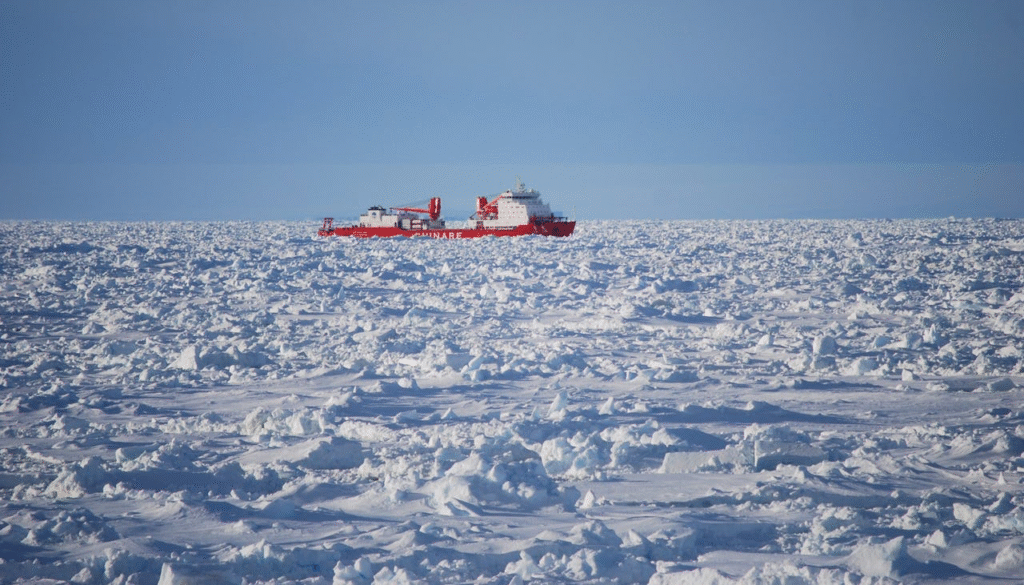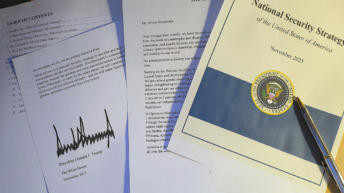
In its sole white paper on the Arctic published in 2018, China claimed to be a ‘Near-Arctic State’. It has also proposed the ‘Polar Silk Road’, an extension to its Belt and Road Initiative. This year, in 2025, China is celebrating the centenary of its official accession to the Arctic. On August 14, 1925, China officially joined the Svalbard Treaty at France’s invitation, allowing China (the then Republic of China) to operate in the Arctic region.
Between August 5 and 7, 2025, China’s indigenous icebreaker Xue Long 2 crossed the Bering Strait between Alaska and Siberia. This was the historical moment when Chinese icebreaker entered the Arctic Ocean. China has deployed five icebreaking research vessels near North American waters, one of the most significant operations in the region.
China’s Activities in the Arctic
According to the Rand Corporation, China’s interest in the Arctic region can be traced back to the signing of the 1920 Spitsbergen Treaty that allows Chinese nationals, along with those of the 43 other state parties to the treaty, to engage in commercial activities on the archipelago of Svalbard, which had been placed under Norwegian sovereignty. China’s brief interest was revived in the 1990s when it became a member of the International Arctic Science Committee in 1996 and built a temporary research station, and later a permanent one, in Svalbard. China’s interest further increased in later years as the Arctic was found to be an ample reservoir of natural resources. After years of lobbying, China became an observer state to the Arctic Council in 2013 and issued its first Arctic Policy in 2018.
Under Xi Jinping, polar research activities have ‘leapfrogged’. For example, in Chapter 4 (Strengthening national strategic science capabilities) of the 14th Five-Year Plan, building heavy icebreakers and establishing a ‘three-dimensional polar observation platform’ are listed as priority areas. In Section 2, table 2 and entry 7 of the document there are mentions of the deep space, deep earth, deep sea, and polar exploration; “We will perform basic scientific research on the origin and evolution of the universe and perspectives on the earth (透视地球), carry out interstellar exploration such as Mars orbiting and asteroid inspection, develop a new generation of heavy-lift launch vehicles and reusable space transportation systems, deep earth exploration equipment, deep sea operations and maintenance (O&M) and equipment test ships, polar three-dimensional monitoring platforms, and heavy icebreakers, and complete construction of Phase IV of the lunar exploration project, Phase II of Jiaolong Sea Exploration (蛟龙探海), and Phase II of Xuelong Polar Exploration (雪龙探 极)”.
China’s XueLong 1, conducted its first field research in the Arctic via the Bering Strait in 1999. In 2004, China opened its first permanent Chinese Arctic research station- the Yellow River Station (黄河站) in Ny-Ålesund, Svalbard.
In 2018, China institutionalised its Arctic policy and formally introduced itself as a ‘near polar nation’. The same document introduced the ‘Polar Silk Road’ concept, which was seen as an extension of the BRI, introduced in September 2013.
China’s Research Activities in the Arctic
China’s Arctic presence has expanded markedly under the Xi Jinping administration, according to its 2018 Arctic Policy. In his 2014 speech, Xi said that China intends to become a ‘polar great power’. In 2017, Xi Jinping met with leaders from seven of the eight members of the Arctic Council, a group of northern countries that had admitted China and four other Asian states as observers in 2013.
China’s Polar Research Institute and other agencies have dispatched icebreakers and research ships on annual voyages. Notably, by 2024, China’s fleet of icebreakers included the original Xue Long (Snow Dragon, ex-Soviet-built) and new vessels Xue Long 2, Ji Di, and Tan Suo San Hao, reflecting heavy investment in polar logistics. Between 2020 and 2025, the Xue Long 2 has conducted about ten scientific expeditions to the Antarctic and Arctic.
Since 2018, China has deployed its first domestically-built polar icebreaker Xue Long 2 (Franz-Stefan Gady, 2018). Its Arctic voyage (15 July–late Sept 2020) covered 12,000 nautical miles and pursued ecosystem research (acidification, pollution, sedimentology). That expedition returned to Shanghai on 29 Sept 2020, having collected a record 18.65-meter Arctic seabed core (at 1870 m depth) – the deepest drill core in Arctic waters – for paleo-climate and pollution analysis.
Between July and September 2023, Xue Long 2 (with Chinese and international scientists, including partners from Russia and Thailand on board) carried out the 13th Chinese Arctic expedition. Its mission focused on the geology/geophysics of the Gakkel Ridge and conducted comprehensive environmental surveys (atmosphere, sea ice, biomes, pollutants). The team collected 130 strains of Arctic bacteria and 68 genetic specimens, enriching China’s polar bio-specimen banks and advancing marine pollution assessment. These outcomes “enhance China’s capability in environmental protection and … marine pollution” study in the Arctic.
In mid-2024, China mounted its first three-ship Arctic deployment: Xue Long 2, the new Polar-Class research vessel Ji Di (commissioned May 2024), and the Sun Yat-sen University–owned icebreaker Zhongshan Daxue Jidi. This unprecedented deployment signalled a deeper Chinese presence in the Arctic. From August 5, 2025, the heavy icebreaker Tan Suo San Hao (Polar Class 4, delivered Dec 2024) set out from Guangzhou to the Russian Arctic.
In early August, it was observed past the Kamchatka peninsula, steaming toward the Bering Strait. Its first voyage underscores China’s push to ‘set eyes on Russia’s Arctic seabed’ for deep-sea research. Meanwhile, in summer 2025, a Chinese flotilla of five polar vessels (led by Xue Long 2, accompanied by the oceanographic ship Shenhai Yihao with manned submersible Jiaolong/Ji Di, Tan Suo San Hao, and others) operated in the Beaufort/Chukchi seas. The U.S. Coast Guard reported tracking this fleet near Alaska in Aug 2025, demonstrating China’s growing Arctic survey capabilities.
China-Russia Joint Arctic Naval Exercise in the Arctic
China and Russia have deepened naval cooperation around the Arctic. In September 2024, the two navies held ‘North-Joint 2024’, a joint maritime exercise in the Pacific-Arctic fringes focused on anti-submarine and aerial defence. Russia deployed large anti-submarine ships (e.g. Admiral Tributs) while China sent the destroyers Xining and Wuxi, the frigate Linyi, and the refueling oiler Taihu. At the diplomatic level, China has signed Arctic cooperation agreements with Russia and invited neighbouring Arctic states to the Belt & Road forums. Beijing maintains the largest Chinese embassy in Reykjavik as part of Arctic outreach.
In 2019, Beijing and Moscow established a joint laboratory on polar technology and equipment at Harbin Engineering University in northeast China. In 2024, the Chinese and Russian coastguards conducted their first joint Arctic patrol. China views itself as a near-Arctic country and an essential stakeholder in the region’s affairs. Russia boasts the world’s largest fleet of polar vessels – 55 in total – and is the only country capable of manufacturing nuclear-powered icebreakers. Apart from scientific research, the two countries are also exploring the commercial potential of developing Arctic shipping routes – the shortest links between the Asia-Pacific and Western Eurasia. Since 2010, China and Russia have organised at least nine joint oceanographic expeditions. In July 2025, the two countries ended a five-year hiatus with a 45-day cruise aboard the Russian ship Akademik M.A. Lavrentyev, focused on studying deep Pacific-Arctic climate history.
In conclusion, China’s Arctic presence has accelerated since its first white paper in 2018. It has invested massively in the technological know-how of icebreakers and other vessels under its ‘Made in China 2025’ industrial policy. Its industrial outlook, strategic investment, and policy implementation have made it one of the key stakeholders in the Arctic region in recent years.





Add comment